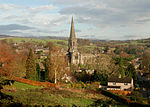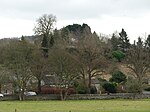Bakewell Town Hall
BakewellCity and town halls in DerbyshireGovernment buildings completed in 1890Use British English from January 2024

Bakewell Town Hall is a municipal building in Anchor Street in Bakewell, a town in Derbyshire in England. The building, which serves a community events venue, is also the home of Bakewell Town Council.
Excerpt from the Wikipedia article Bakewell Town Hall (License: CC BY-SA 3.0, Authors, Images).Bakewell Town Hall
Bath Street, Derbyshire Dales
Geographical coordinates (GPS) Address Nearby Places Show on map
Geographical coordinates (GPS)
| Latitude | Longitude |
|---|---|
| N 53.2138 ° | E -1.675 ° |
Address
Bath Street
Bath Street
DE45 1BX Derbyshire Dales
England, United Kingdom
Open on Google Maps











